The Deep Sky Objects
What is a deep sky object? Generally speaking
it's any object in the sky that isn't a star or in our solar system. Most
deep sky objects are faint, diffuse and require a telescope to see. They
make for spectacular photographs but often appear as little more than a
faint smudge of light to your eye, even as seen through a large telescope.
Deep sky objects break down into several categories:
Open Star Clusters
Globular
Star Clusters
Diffuse Nebulae
Dark Nebulae
Planetary
Nebulae
Supernova
Remnants
Galaxies
Galaxy Groups
Quasars
Gravitational
Lenses
Open Star
Clusters
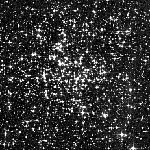 These
are loose groupings of many stars. Some open clusters are large and spread
out. For instance, the Hyades, Pleiades and the Beehive are all open clusters
that you can see with your naked eye. Others are small and faint. If the
stars are very faint the cluster may look more like a hazy patch of sky
in your telescope rather than individual stars. When you can make out the
individual stars we say the cluster is said to be resolved. Generally
speaking, the larger the aperture (diameter) of your telescope the more
clusters you will be able to resolve into individual stars. Some open clusters
have only a few member stars, while the hundreds of stars in others look
like jewels spread out across the field of view. Take some time to compare
the colors of the stars in a cluster. For instance, there is usually at
least one bright red giant star, often near the center. These
are loose groupings of many stars. Some open clusters are large and spread
out. For instance, the Hyades, Pleiades and the Beehive are all open clusters
that you can see with your naked eye. Others are small and faint. If the
stars are very faint the cluster may look more like a hazy patch of sky
in your telescope rather than individual stars. When you can make out the
individual stars we say the cluster is said to be resolved. Generally
speaking, the larger the aperture (diameter) of your telescope the more
clusters you will be able to resolve into individual stars. Some open clusters
have only a few member stars, while the hundreds of stars in others look
like jewels spread out across the field of view. Take some time to compare
the colors of the stars in a cluster. For instance, there is usually at
least one bright red giant star, often near the center.
Like many deep sky objects, some open clusters
look better in small telescopes than they do in large ones. The reverse
is also true. One of the tricks to successful deep sky observing is to
choose targets that are appropriate for your telescope. The Wild
Duck cluster (M11) is always worth a look in any telescope. The Beehive
is best in smaller instruments. NGC 2158 is best in larger instruments.
Why are stars in clusters? Stars form from
giant collections of gas clouds in space when some sort of shock wave passes
through, compressing the clouds such that they begin to collapse and form
stars. Unlike people, stars are formed all together in this way. Over time
these stars may wander away from each other, but depending on many factors,
for a time they stay together in a group. The giant gas clouds where stars
form are concentrated in the plane of our galaxy -- along the Milky Way,
so this is also where most open clusters are found.
Globular
Clusters
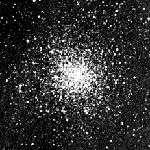 These
star clusters are much larger groupings of stars that are drawn together
into a much more concentrated, spherical shape than the open clusters.
Globular clusters typically have hundreds of thousands of stars all packed
into a tight ball. Except perhaps for Saturn's rings, there may be no view
more breathtaking than the myriad stars of a globular filling your field
of view. Some of the best examples: M13, Omega Centauri, M22 and M15. These
star clusters are much larger groupings of stars that are drawn together
into a much more concentrated, spherical shape than the open clusters.
Globular clusters typically have hundreds of thousands of stars all packed
into a tight ball. Except perhaps for Saturn's rings, there may be no view
more breathtaking than the myriad stars of a globular filling your field
of view. Some of the best examples: M13, Omega Centauri, M22 and M15.
Stick to the brighter globulars for the
most stunning views. Large aperture instruments will resolve the smaller,
fainter globulars; they make good targets for these scopes when you get
tired of looking at just the bright ones.
Globular star clusters are composed of
old stars. Unlike the open clusters, which form continuously, all the globulars
formed very long ago. It appears that globular clusters form when two galaxies
collide; such a collision stimulates star formation on much larger scales.
The globular clusters of our galaxy are all approximately the same age;
perhaps formed when our galaxy collided with another long ago. They are
found outside of the disk of or galaxy, forming a large spherical cloud
of clusters about the galactic center. That's why most globulars are visible
in northern hemisphere summer when sagittarius is in view. The center of
our galaxy is in this direction.
Diffuse
Nebulae
 Diffuse
Nebulae (pronounced nebulee) are clouds of glowing gas and dust. Our galaxy
is filled with these clouds, which lie mostly along the Milky Way. Most
of this gas is dark, but when a bright, hot star is nearby it can glow.
There are two ways for the gas to glow. Both ways require lots of blue
and UV light entering the nebula. Massive, hot stars are a excellent source
of such light. Diffuse
Nebulae (pronounced nebulee) are clouds of glowing gas and dust. Our galaxy
is filled with these clouds, which lie mostly along the Milky Way. Most
of this gas is dark, but when a bright, hot star is nearby it can glow.
There are two ways for the gas to glow. Both ways require lots of blue
and UV light entering the nebula. Massive, hot stars are a excellent source
of such light.
It is these nebulae that cause the most
disappointment for beginners expecting to see the vivid detail and colors
found in long exposure photographs. Your eye simply can't see color and
faint detail as well as a camera can. So in most cases these nebulae appear
as faint, hazy patches of sky. One of the best nebulae in the sky is M42,
an HII region in Orion. This nebula may appear as a hazy patch even to
the naked eye. In all but the tiniest of telescopes it forms a beautiful
twisting, swirling mass of clouds, usually a pale gray or slight green
color. There are some people who claim to see a tinge of pale red as well.
Another good example is the Swan.
The light from a star becomes scattered
as it passes through the a gas cloud, in much the same way that sunlight
is scattered by our atmosphere. It is the dust particles in the cloud that
do the scattering. The blue light is scattered more easily, so the other
colors tend to pass right on through. The blue light, however, gets scattered
in all directions. So, if you stand off to the side and look at the cloud,
it appears to glow blue from the light being scattered in your direction.
Astronomers call this a reflection nebula. They appear distinctly
blue in photographs, but appear only as a hazy gray in a telescope.
The other way for a cloud to glow is when
the light from the star is absorbed by the gas atoms and then remitted.
Hydrogen gas atoms like to absorb UV light. When they do their only electron
uses that energy to break free of the atom and go flying off. Eventually
it meets another hydrogen nucleus and recombines to make a hydrogen atom
again. It must shed the energy it stole before; emitting it in some random
direction as mostly red light. The process at work here is similar to that
of neon sign. Rather than a wide range of colors, the light from these
clouds is emitted over a set of certain colors only. Your eye has trouble
with this -- that's why neon signs look so weird. Astronomers call these
nebulae
HII regions. They appear distinctly red in photographs,
but for the most part they too appear as a pale gray in the telescope.
Dark Nebulae
These are clouds
of gas and dust that hide the stars behind them. The gas in interstellar
space is accompanied by very tiny grains of dust, much like that found
in cigarette smoke. If the cloud is dense enough, these grains scatter
and absorb enough light as to render the stars beyond invisible. These
nebulae are perhaps best enjoyed with a pair of binoculars. The summer
Milky Way is a particularly good place to look. From a dark sight you will
see large dark lanes even to the naked eye. In a telescope or binoculars
sweep along Sagittarius and Scorpius, and all the way north to Cygnus.
Look for patches where the stars seem to be missing.
Some of the better examples are the Coal
Sack and Barnard's E.
The most famous dark nebula is the Horsehead.
This nebula in Orion is famous from photographs, but is very, very difficult
to see visually in a telescope -- even big ones. The distinctive, horse-head
shape is outlined by the dark nebula against a very faint diffuse nebula.
The problem is that if you can't see the the diffuse nebula, then you won't
be able to make out the shadow of the horsehead. Seeing this one is not
for beginners.
Planetary
Nebulae
 These
are another sort of glowing gas cloud. They are formed when a star reaches
middle age. These stars will swell to many times their original size, to
the point where they puff their outermost layers of gas out into space.
The hot star at the center makes this gas glow much like an HII region,
except in this case we mostly see glowing gas other than hydrogen, such
as oxygen. By the way, these nebulae have absolutely nothing to do with
planets. These
are another sort of glowing gas cloud. They are formed when a star reaches
middle age. These stars will swell to many times their original size, to
the point where they puff their outermost layers of gas out into space.
The hot star at the center makes this gas glow much like an HII region,
except in this case we mostly see glowing gas other than hydrogen, such
as oxygen. By the way, these nebulae have absolutely nothing to do with
planets.
In the telescope most planetary nebulae
appear slightly blue or green, depending on the observer. To some people,
like myself, all but the most colorful Planetaries merely look pale gray.
These nebulae come in all sizes and shapes.
Some are listed as being very bright, but they are so large that the light
is spread over a wide area. This makes seeing them very difficult. At best
some of these appear as a sort of brightening of the background sky. A
good example is the Helix. Just
finding an object like this in small to moderate telescopes is all you
can expect. But many deep sky observers will tell you that the hunt is
what they enjoy the most. The more difficult it is to find an object in
a particular telescope the more satisfying it is when you finally convince
yourself that you have found it.
Other planetaries are smaller, such as
the famous Ring Nebula in Lyra. This
one is a classic object for beginners because it is bright, looks great,
is not all that small, and is easy to find between two naked-eye stars.
Some other classics for all telescopes are the Cat's Eye, Saturn
nebula, Ghost of Jupiter, Blinking
planetary and the Owl.
The majority of planetaries that you will
find in a catalog are tiny and faint. Observing these tiny nebulae are
one area where large-aperture telescopes (16" or greater) really shine.
The light gathering power of these scopes allows for high magnification,
which can reveal intricate detail where a smaller scope can only see a
hazy spot. A few great planetaries for large instruments are NGC
1535, NGC 2371-2, and NGC
2440.
Supernova
Remnants
When a star explodes as a supernova it leaves behind an expanding glowing
cloud of gas. These supernova remnants range from the bright Crab nebula
(M1) to the much larger and fainter Veil.
The Crab nebula is the brightest and best
known of these remnants, visible as a hazy spot in any small telescope.
But the majority of these remnants are faint and diffuse, requiring a large
aperture telescope (>16"), often aided by an OIII or UHC filter.
Galaxies
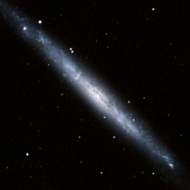 These
are other "island universes" filled with stars, clusters and nebulae of
their own. Just about everything you see in the sky -- the stars, clusters,
and nebulae -- are all in our own Milky Way galaxy. It is an immense, disk-shaped
structure with perhaps a trillion stars in it. The distances to the objects
we see around us in our own galaxy are measured in hundreds or thousands
of light years. But other galaxies are much farther away; even the closest
galaxies are millions of light years distant. The only exceptions are the
two companion galaxies to our own galaxy, small galaxies which orbit about
our Milky Way -- the Magellanic Clouds. The clouds appear a large hazy
patches to the naked eye. They can not be seen from mid northern latitudes. These
are other "island universes" filled with stars, clusters and nebulae of
their own. Just about everything you see in the sky -- the stars, clusters,
and nebulae -- are all in our own Milky Way galaxy. It is an immense, disk-shaped
structure with perhaps a trillion stars in it. The distances to the objects
we see around us in our own galaxy are measured in hundreds or thousands
of light years. But other galaxies are much farther away; even the closest
galaxies are millions of light years distant. The only exceptions are the
two companion galaxies to our own galaxy, small galaxies which orbit about
our Milky Way -- the Magellanic Clouds. The clouds appear a large hazy
patches to the naked eye. They can not be seen from mid northern latitudes.
Galaxies, like stars, often cluster together
in groups. Our Milky Way is a member of one such group, which we call the
local
group. The two brightest galaxies in the northern sky are members of
our local group; M31 (the Andromeda
galaxy), and M33 in Triangulum. M31 can be glimpsed by the naked eye as
an elongated hazy patch and appears clearly in binoculars. M33 would be
an easy target for small telescopes, except its light is spread over such
a large area that it never appears more than a round, hazy patch of sky.
This makes it difficult for first time observers. Other local group members
are also large, spreading their light out so much as to make them extremely
difficult to see at all. Keep this in mind when you see the magnitude listed
for a galaxy -- the large ones may be difficult or impossible to spot even
if they are supposedly bright enough to see in your scope.
The vast majority of galaxies appear as
small hazy patches of sky. There are two main types of galaxies; ellipticals
and spirals. Elliptical galaxies are round or egg-shaped, often with a
bright, starlike center. They look the same from all directions and are
otherwise featureless. Some of the brighter ellipticals are M87 and M84.
Spiral galaxies are disk-shaped like our
own Milky Way. They are flat with a round bulge at the center, much like
a classic flying saucer. Their apparent shape depends on the angle from
which we are viewing them. A face-on spiral galaxy will generally appear
round. The center may appear starlike, or it may be a round or oval bright
spot. Photographs will show winding spiral arms in such galaxies, but in
all but a few cases these arms are invisible in the telescope. Some good
examples of face-on spiral galaxies are M51,
M33 and M101.
At the other extreme we have spiral galaxies
seen edge-on. Here the galaxy appears long and thin, with a thickening
in the middle. We may see dark dust lanes running the length of the galaxy.
Such galaxies are often the most interesting in the telescope. Some of
the best examples are the Sombrero, Spindle,
M82,
and NGC 253.
We see most spiral galaxies from a viewing
angle between these two extremes.
Galaxy Groups
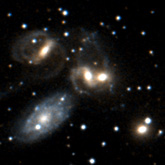 These
are clusters of galaxies. Hickson compact galaxy groups usually have four
or five members within the same field of view. Most of these clusters contain
faint galaxies that are generally observable only in large aperture instruments.
Good examples are Stephan's Quintet (pictured right) and Hickson
68. These
are clusters of galaxies. Hickson compact galaxy groups usually have four
or five members within the same field of view. Most of these clusters contain
faint galaxies that are generally observable only in large aperture instruments.
Good examples are Stephan's Quintet (pictured right) and Hickson
68.
Other galaxy clusters can be much larger.
Some of the best examples are the Virgo
Cluster, Fornax Cluster.
Quasars
These are faint
starlike objects that are at great distances. They represent the extremely
bright centers of apparently otherwise normal galaxies. It appears that
most galaxies have a supermassive black hole which lurks in the center.
When a galaxy collides with another, gas and dust is sent toward the center,
where some of it finds its way into orbit about the black hole. The immense
gravity causes the material in orbit to emit enormous amounts of energy.
This quasar at the center of such a galaxy outshines the rest of the galaxy
by so much that even in the largest telescope, they are all we see of the
galaxy. Thus they appear starlike in the telescope.
Given time, the material will no longer
fall into the black hole and the quasar will no longer shine brightly.
Most people believe that black holes "suck", but this is a myth. Matter
is no more likely to fall into a black hole than the earth is to fall into
the sun, and for much the same reason -- the motion of the earth causes
it to orbit around the sun rather than fall into it. But given the infall
of enough material, particularly gas and dust, some will eventually wind
up close enough to eventually spiral in. But the process is inefficient,
so it takes extreme conditions for this to happen. It appears that in the
early universe galaxies collided more often, causing large amounts of gas
and dust to fall toward the galactic center, so quasars were more common
then. But today, most of the quasars are "off". Because it takes light
time to travel great distances, when we look out into the universe we are
looking back in time; the farther away we look the farther back in time
we are looking. Most quasars occurred long ago, so they are found at great
distances.
All this makes quasars much more interesting
to ponder than to look at. You need to look with your mind as well as your
eye. When you find one of these they look just like an ordinary star. It
is knowing what you are looking at that makes them so amazing and worth
hunting one down. The brightest quasar is also the first discovered; 3C
273. It is visible in a 6" telescope.
Gravitational
Lenses
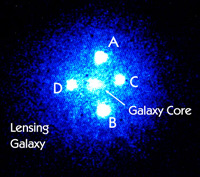 These
usually concern distant quasars. When the light from the quasar passes
near a massive galaxy on its journey toward your scope, it can be bent
by the gravity of the galaxy in much the same way a lens would. The result
is often two or more images of the same quasar. These multiple images are
typically small and very faint. They pose a challenge to view even in telescopes
18" or greater. The two best examples are Einstein's Cross and the Twin
Quasar (Q0957+561A/B). These
usually concern distant quasars. When the light from the quasar passes
near a massive galaxy on its journey toward your scope, it can be bent
by the gravity of the galaxy in much the same way a lens would. The result
is often two or more images of the same quasar. These multiple images are
typically small and very faint. They pose a challenge to view even in telescopes
18" or greater. The two best examples are Einstein's Cross and the Twin
Quasar (Q0957+561A/B).
|